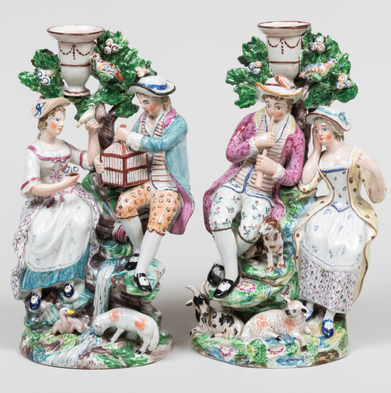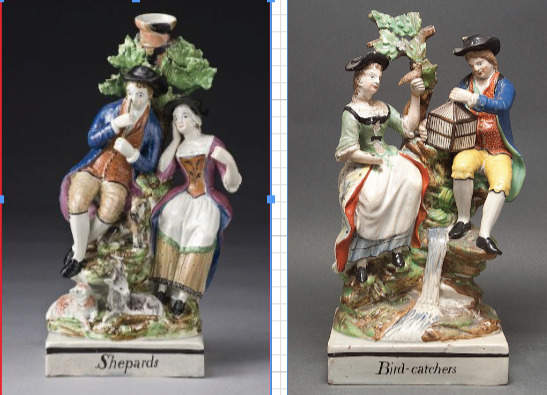 Courtesy Andrew Dando.
Courtesy Andrew Dando. The vast majority of Staffordshire figure models have companion models, so what did Wood pair with his Bird Catchers? He must have loved shepherds and shepherdesses because he made several pairs, and apparently he thought that a bucolic shepherd and shepherdess fitted the bill. Below is a pair of pottery models that are undeniably Wood’s work. Their bocages (remarkably intact) are typical, and the rainbow-like colors on the bases only occur on figures associated with Wood.
Wood also made this pair of models decorated in colored glazes, as you see below. Each to his own, and some may prefer this mode of decoration, but for me those pretty enamel colors win any day.
 Courtesy John Howard
Courtesy John Howard As I type this post, I am, as always, aware that my vast photo archive makes it seem that such figure groups can be found with ease. Far from it. But don't let that stop you looking, and don't hesitate to buy a beautiful single--in my opinion, that's far better than a poor pair. Many examples have lost their bocages over the years yet still retain their beauty, but avoid anything with an extensively restored bocage.
Also, remember that nasty reproductions of the shepherds group can be found easily. Made in Asia in recent years, they are crude, garish object, and some even have "WOOD" scratched beneath. The deliberate dirty crazing betrays them for what they are.
Yet another few words of advice: if you see other early figure groups of this form, do not assume Ralph Wood made them. After Wood's death, his molds passed to others. In particular, the Dudson factory made figure groups from these molds in the early 1800s. They are charming, but Ralph Wood's are the best.
If you want to know more about Ralph Wood’s work, please refer to my PDF on that subject, accessed by clicking here.




















